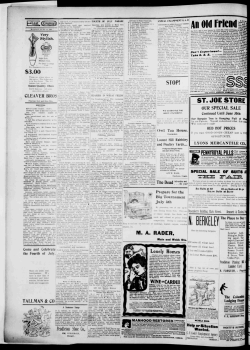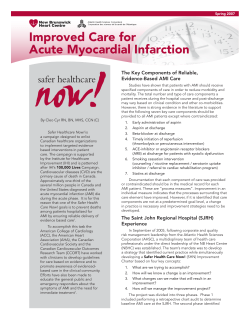
NSAIDs acute myocardial infarction Use of in patients with
Use of NSAIDs in patients with acute myocardial infarction Alain Vanasse, MD PhD1,2 Artur de Brum-Fernandes, MD PhD2,3 Josiane Courteau, PhD2 Danielle Pilon, MD MSc3 2. Centre de Recherche Clinique Étienne-Le Bel, Université de Sherbrooke, Sherbrooke, Québec 3. Département de médecine, Université de Sherbrooke, Sherbrooke, Québec Groupe de recherche PRIMUS: www.pages.usherbrooke.ca/primus Groupe de recherche ◆ In Lee et al, the risk of all-cause death was reduced among non-selective NSAIDs users, even in the high risk population with a preexisting coronary artery disease and is not related to the NSAIDs used (Naproxen, Ibuprofen, Diclofenac, other NSAIDs) ◆ Similarly, Stürmer et al showed a significant decreased death risk associated to non-selective NSAIDs On the other hand, Gislason et al found a significant increased risk of death associated with both Ibuprofen and Diclofenac in a population with AMI, but this risk seemed to be observed with high daily dosage only. With low dosage of Ibuprofen, the risk of death was significantly decreased Finally, MacDonald et al showed a significant increased risk of both all-cause and cardiovascular death with aspirin and Ibuprofen as compared to aspirin alone, but a non significant decrease with aspirin and Diclofenac ◆ Cardiovascular mortality ◆ Recurrent AMI ◆ 5837 (21.8%) patients died ◆ 3634 (13.5%) died from a cardiovascular disease ◆ 2611 (9.7%) were readmitted for AMI This was particularly true for diclofenac users as compared to non diclofenac users NSAIDs users were less likely to die from cardiovascular disease than non NSAIDs users This was particularly true for naproxen users as compared to non naproxen users Characteristics of population according to event-points CVD DEATH ALL-CAUSE DEATH Cases (n=5837) Controls (n=116668) p-value Cases (n=3634) AMI REHOSPITALIZATION Controls (n=72623) p-value Cases (n=2611) Controls (n=52203) p-value Gender , % Female 0.978 47.4 0.972 44.7 53.8 53.8 52.6 52.5 55.3 55.3 77.8 (7.2) 77.1 (6.7) < .001 77.9 (7.2) 77.3 (6.7) < .001 76.0 (6.7) 75.6 (6.5) 0.002 2.5 (2.2) 1.5 (1.7) < .001 2.4 (2.0) 1.5 (1.7) < .001 1.9 (1.8) 1.5 (1.7) < .001 17.3 (22.5) 15.9 (20.8) < .001 16.8 (20.0) 15.9 (20.7) < .001 13.4 (12.3) 15.9 (20.0) < .001 3.4 9.3 < .001 3.0 9.0 < .001 4.6 10.9 < .001 Aspirin 30.9 52.3 < .001 35.5 52.2 < .001 51.5 54.1 Beta-blockers 15.9 33.8 < .001 18.7 33.8 < .001 33.4 36.3 0.002 ACE 28.9 32.1 < .001 33.7 32.0 < .001 36.9 31.8 < .001 3.4 8.4 < .001 3.9 8.0 < .001 7.8 8.7 0.094 175 (3.0) Male Age, mean (SD) (y) Methods Methods Comorbidity, mean (SD) Length of stay, mean (SD) (d) Revascularization, % 46.2 6.2 47.5 44.7 No statistically significant increased risk of recurrent AMI was observed in NSAIDs users 0.994 Cardioprotective drugs, % Design We conducted matched nested case-control studies in a retrospective population-based cohort Covariables ◆ ◆ ◆ Study population The cohort includes all elderly patients living in Quebec and hospitalized for an AMI between 1992 and 1996. Patients with an AMI in the year preceding index hospitalization or who died at index hospitalisation were excluded Data sources ◆ ◆ ◆ ◆ ◆ ◆ in a population with AMI in the province of Quebec Like selective NSAIDs (COX-2), nonselective NSAIDs have raised concerns based on several studies reporting an increased risk of cardiovascular events Mortality studies show contradictory results Mortality NSAIDs users were less likely to die than non NSAIDs users During the 2-year period following hospital discharge The objective of the study was to measure the impact of exposition to NSAIDs on: Non-steroidal anti-inflammatory drugs (NSAIDs) are drugs used to reduce pain, fever and inflammation Summary Summary A total of 26,822 patients survived a « new » AMI hospitalization between 1992 and 1996 in the province of Quebec Objective Objective Introduction Introduction ◆ Results Results Fonds de la recherche en santé PRIMUS Few studies show the impact of nonselective NSAIDs on all-cause and cardiovascular mortality in the general population and even fewer in the high-risk population of patients who survived an acute myocardial infarction (AMI) and its impacts on cardiovascular outcomes 1. Département de médecine de famille, Université de Sherbrooke, Sherbrooke, Québec ◆ Provincial hospital discharge database (Med-Echo) Provincial death register Provincial beneficiary database (RAMQ) Provincial pharmacological database (RAMQ) Study outcomes ◆ ◆ ◆ All-cause death Cardiovascular death (ICD-10: I20-I25, I44-I52) Hospital readmission for AMI (ICD-9: 410) Drug expositions Every patient who filled a prescription at a pharmacy was considered exposed to the drug for the length of time of the prescription ◆ ◆ ◆ Age Gender Comorbidity index Length of stay at index hospitalization Revascularization (PTCA or CABG) at index hospitalization Exposure to cardio-protective drugs Aspirin, Beta-blockers, ACE inhibitors, Statins Statins 0.008 NSAID exposure, n (%) Any NSAIDs 4779 (4.1) < .001 93 (2.6) 4779 (4.1) < .001 117 (4.5) 2141 (4.1) 0.341 Ibuprofen 11 (0.2) 317 (0.3) 0.230 7 (0.2) 194 (0.3) 0.393 8 (0.3) 153 (0.3) 0.902 Naproxen 42 (0.7) 1174 (1.0) 0.031 16 (0.4) 710 (1.0) 0.001 26 (1.0) 542 (1.0) 0.834 Diclofenac 42 (0.7) 1492 (1.3) < .001 28 (0.8) 880 (1.2) 0.017 32 (1.2) 633 (1.2) 0.953 Other NSAIDs 80 (1.4) 1873 (1.6) 0.162 42 (1.2) 1114 (1.5) 0.069 53 (2.0) 848 (1.6) 0.112 This study shows no statistically significant increased risk of recurrent AMI in NSAIDs users and their risk of cardiovascular death is reduced Hazard Ratio (HR) Selection of cases and controls For each outcome, 20 controls per case were randomly drawn from each case’s risk set Matched for age (±5 years), gender and date of cohort entry (±30 days) ◆ Statistical analyses Conditional logistic regressions were used to estimate the hazard ratios (HR) of outcome events associated with NSAIDs Models were adjusted for comorbidity index, length of stay and revascularization at index hospitalization, and exposures to aspirin, beta-blockers, ACE inhibitors and statins ◆ 0.33 0.5 1 2 3 Adjusted HR (95% CI) ALL-CAUSE DEATH Adjusted* hazard ratios (HR) with their 95% confidence intervals estimated from the conditional logistic regression analyses *Adjusted for age, gender, time of cohort entry, hospital length of stay and revascularization at index hospitalization, exposure to aspirin, ACE inhibitors, beta blockers and statins Any NSAIDs 0.84 (0.72-0.98) * Ibuprofen 0.79 (0.43-1.44) Naproxen 0.81 (0.59-1.11) Diclofenac 0.69 (0.50-0.92) * Other NSAIDs 0.97 (0.77-1.22) Conclusions Conclusions Further studies are needed to better understand the mechanisms implicated in these effects CVD DEATH Any NSAIDs 0.72 (0.58-0.89) * Ibuprofen 0.81 (0.38-1.73) Naproxen 0.51 (0.31-0.84) * Diclofenac 0.74 (0.50-1.08) Other NSAIDs 0.80 (0.59-1.10) References AMI READMISSION Any NSAIDs 1.08 (0.89-1.31) Ibuprofen 1.04 (0.51-2.14) Naproxen 0.96 (0.65-1.43) Diclofenac 1.01 (0.70-1.44) Vanasse A, Pilon D, Courteau J, de Brum-Fernandes A. Use of cyclooxygenase2 inhibitors with patients with acute myocardial infarction and its impact on cardiovascular outcome. Poster presentation. ACR (American College of Rheumatology) Annual Scientific Meeting, Boston, November 6-11, 2007. 1.22 (0.92-1.62) Other NSAIDs 0.33 0.5 1 2 McGettigan P, Henry D. Cardiovascular risk and inhibition of cyclooxygenase : A systematic review of the observational studies of selective and non-selective inhibitors of cyclooxygenase 2. JAMA 2006;296:1633-44. 3 * p<.05; ** p<.001 Gislason GH, Jacobsen S, Rasmussen JN, Rasmussen S, Buch P, Friberg J, Schramm TK, Abildstrom S, Kober L, Madsen M, Torp-Pedersen C. Risk of death and reinfarction associated with the use of selective cyclooxygenase-2 inhibitors and non-selective nonsteroidal antiinflammatory drugs after acute myocardial infarction. Circulation 2006;113:2906-13. Design: Mireille Courteau Hernandez-Diaz S, Varas-Lorenzo C, Rodriguez LAG. Non-steroidal antiinflammatory drugs and the risk of acute myocardial infarction. Basic & Clinical Pharmacology & Toxicology 2006;98:266-74. Lee TA, Bartle B, Weiss KB. Impact of NSAIDs on mortality and the effect of preexisting coronary artery disease in US veterans. The American Journal of Medicine January 2007;120(1). Stürmer T, Schneeweiss S, Brookhart MA, Rothman KJ, Avorn J, Glynn RJ. Analytic strategies to adjust confounding using exposure propensity scores and disease risk scores: nonsteroidal anti-inflammatory drugs and short-term mortality in the elderly. Am J Epidemiol 2005;161:891-8. Kearney PM, Baigent C, Goldwin J, Halls H, Emberson JR, Patrono C. Do selective cyclo-oxygenase-2 inhibitors and traditional non-steroidal antiinflammatory drugs increase the risk of atherothrombosis? Meta-analysis of randomised trials. BMJ 2006;332:1302-8. D'Hoore W, Bouckaert A, Tilquin C. Practical considerations on the use of the Charlson comorbidity index with administrative data bases. Journal of Clinical Epidemiology 1996;49(12):1429-33.
© Copyright 2025





















